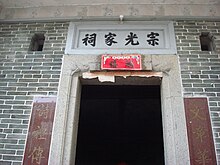





Tin Sam Village or Tin Sam Tsuen (Chinese: 田心村), sometimes transliterated as Tin Sum, is a village in Tai Wai, Sha Tin District, Hong Kong. It is located west of Sun Chui Estate, north of Lung Hang Estate, and southeast of Festival City. Part of Tin Sam Village consists of Tin Sam Wai (田心圍), a historic walled village.
Administration
Tin Sam is a recognized village under the New Territories Small House Policy. It is one of the villages represented within the Sha Tin Rural Committee. For electoral purposes, Tin Sam Tsuen is part of the Tin Sum constituency., which was formerly represented by Tsang Kit until July 2021.
History
Tin Sam was founded in the late Ming Dynasty (1368-1644). It was a Punti walled village, historically inhabited by the Choi (蔡), the Wai (韋), the Leung (梁), the Tsang (曾) and the Liu (廖). A moat was built for its protection, and was later filled up and used as a fish pond.
The Che Kung Temple in Tai Wai was built and initially managed by Tin Sam Village. The village lost its managerial rights in the late 19th century in a lawsuit against the Kau Yeuk (九約, "Alliance of Nine" ), a regional organization of various groups in Sha Tin Valley, that was settled in a lawsuit at the yamen. The Kau Yeuk had provided evidence that it made significant contributions to the renovation of the temple. The Kau Yeuk could prove its case by referring to the rhymed couplets that were inscribed on both sides of the main entrance and that bore its name. The temple was subsequently jointly managed by nine villages of Sha Tin, while Tin Sam Village continued to enjoy some privileges in the worship of Che Kung. Since 1936, the temple has been administered by the Chinese Temples Committee.
Features
Historic buildings in the village include the Choi Ancestral Hall, also known as Chung Kwong Family Hall (宗光家祠), built around the 1920s, the Leung Ancestral Halls (梁氏祠堂), two ancestral houses, largely rebuilt and occupied by tenants, the Liu Ancestral Hall (廖氏祠堂), and the Entrance Gate, built during the Qing Dynasty. Two rectangular holes are above the front doorways of the Gate for feng shui benefit and for security watching.
Festival
The Da Jiu Festival of the village is organized every 10 years. It was celebrated in December 2006 and in 2016.
See also
- Tai Wai for a detailed list of the other villages in the area
- San Tin Village
- Walled villages of Hong Kong
- List of villages in Hong Kong
References
- "List of Recognized Villages under the New Territories Small House Policy" (PDF). Lands Department. September 2009.
- "Recommended District Council Constituency Areas (Sha Tin District)" (PDF). Electoral Affairs Commission. Retrieved 31 March 2022.
- "Sha Tin District Council - List of Former Sha Tin DC Members". District Council. Retrieved 31 March 2022.
- ^ Antiquities Advisory Board. Historic Building Appraisal. Entrance Gate, Tin Sam
- Ip, Hing-fong (1995). An historical geography of the walled villages of Hong Kong (Postgraduate Thesis, Master of Philosophy). University of Hong Kong. p. 92.
- Faure, David (1986). The structure of Chinese rural society: lineage and village in the eastern New Territories, Hong Kong. Oxford University Press. p. 119-121. ISBN 9780195839708.
- ^ Antiquities Advisory Board. Historic Building Appraisal. Choi Ancestral Hall, No. 142 Tin Sam
- ^ Antiquities Advisory Board. Historic Building Appraisal. Che Kung Temple, Che Kung Miu Road, Tai Wai
- SCL - NEX/2206 EIA Study for Tai Wai to Hung Hom Section. Environmental Impact Assessment Report.Appendix 4.3. Built Heritage Survey. October 2011
- East Rail Extensions - Tai Wai to Ma On Shan. Environmental Impact Assessment Report. Archaeological and Cultural Resources, 1999
- SCL - NEX/2206 EIA Study for Tai Wai to Hung Hom Section, Final Environmental Impact Assessment Report, Figure 4.2.1. Locations of Known Built Heritages (Sheet 1 of 8), October 2011. Shows the location of the historic buildings of Tin Sam Village.
- Choi, C.C. (1990). "Studies on Hong Kong Jiao Festivals" (PDF). Journal of the Royal Asiatic Society Hong Kong Branch. 30: 26–43. ISSN 1991-7295.
Further reading
- Cody, Jeffrey W.; Richardson, James R. (1997). "Urbanizing forest and Village Trees in Hong Kong's Sha Tin Valley, 1976-1997" (PDF). Traditional Dwellings and Settlements Review. IX (1). Hong Kong: 21–33. Archived from the original (PDF) on 2016-01-09.
- Hase, P. H. (2020). "Chapter 3. Traditional Sha Tin". Settlement, Life, and Politics - Understanding the Traditional New Territories. Royal Asiatic Society Hong Kong studies series. City University of Hong Kong Press. pp. 215–320. ISBN 9789629374419.
External links
- Delineation of area of existing village Tin Sum (Sha Tin) for election of resident representative (2019 to 2022)
- Antiquities Advisory Board. Pictures of Tin Sam Wai entrance gate
- Antiquities Advisory Board. Pictures of Choi Ancestral Hall
22°22′11″N 114°10′41″E / 22.369805°N 114.178170°E / 22.369805; 114.178170
Categories: